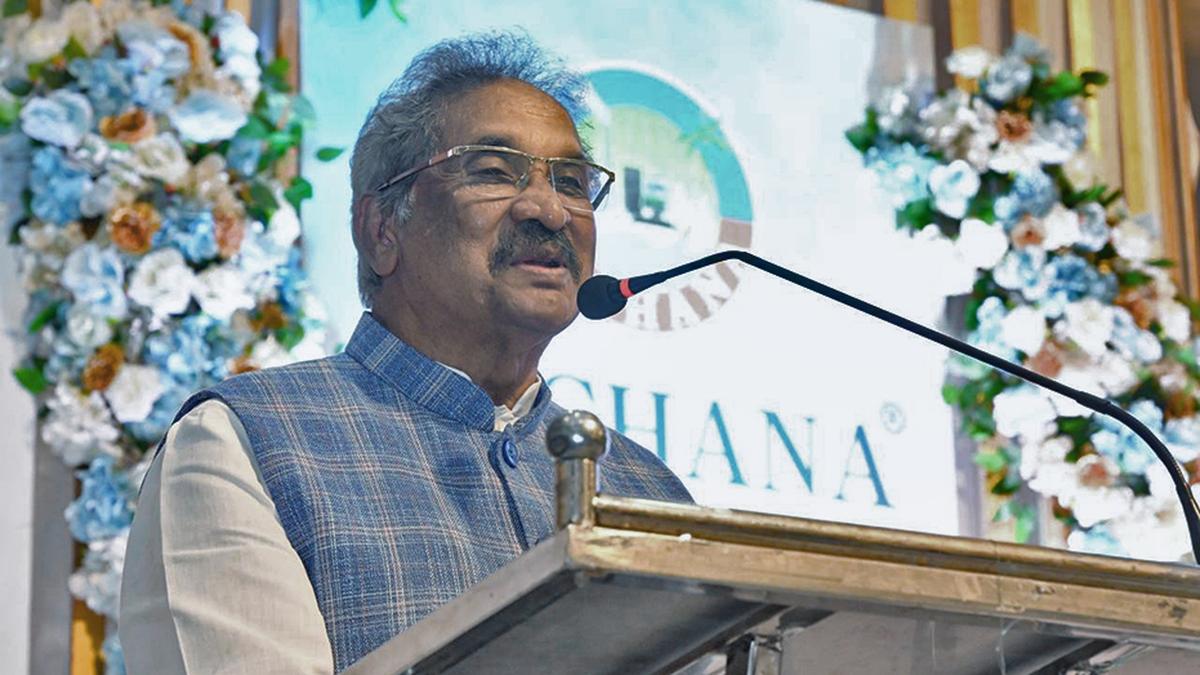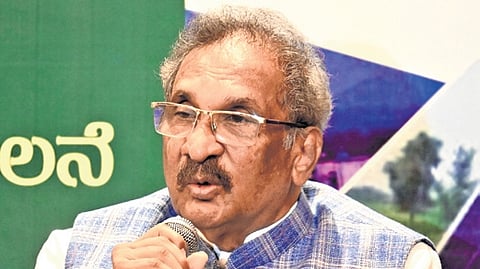Karnataka Energy Minister K.J. George has strongly defended the State government’s decision to move forward with the Sharavathi Pumped Storage Project (PSP), calling it an “essential initiative for Karnataka’s energy security and sustainable development.” The ₹5,000-crore project, proposed in the eco-sensitive Western Ghats region of Shivamogga district, has faced intense criticism from environmentalists who warn of irreversible ecological damage. Addressing reporters in Bengaluru, George argued that the project is being wrongly portrayed as anti-environmental and insisted that it will have minimal forest impact due to advanced tunneling technology and scientific mitigation measures.
The debate around the Sharavathi project has also reignited discussions about India’s approach to sustainable development. Critics argue that the country’s renewable transition should not replicate the extractive mindset of earlier industrial projects. They call for an energy strategy that places ecological preservation on equal footing with power generation. Environmental think tanks have proposed a “Green Infrastructure Code,” which would mandate biodiversity assessments and environmental offset programs for all energy-related constructions, ensuring long-term ecological integrity.
Minister George has dismissed allegations of secrecy, stating that all necessary studies are being conducted under expert supervision. He mentioned that the Sharavathi PSP has been designed to operate with maximum efficiency, storing up to 2,000 megawatts of renewable energy for peak-hour use. The project, according to him, will contribute significantly to Karnataka’s carbon neutrality goals and help manage energy fluctuations caused by erratic monsoon patterns affecting hydropower production. He emphasized that halting such projects would risk future energy stability and increase dependency on fossil fuels.
George stated that the Sharavathi PSP is a critical component of Karnataka’s renewable energy strategy, designed to stabilize the grid amid rising solar and wind power integration. “We cannot afford frequent power shortages or fluctuations in renewable supply,” he said. The minister explained that pumped storage systems act like large batteries — storing excess renewable energy during non-peak hours and releasing it when demand surges. He also clarified that the project area includes previously altered landscapes with limited biodiversity, contradicting claims of massive deforestation. “This project will not destroy forests; it will ensure a greener, self-reliant Karnataka,” he added.
Critics, however, continue to express skepticism, pointing out that the project’s location lies within a biodiversity hotspot and could threaten endangered flora and fauna. Environmental groups such as the Western Ghats Conservation Network have demanded that the government release the full Environmental Impact Assessment (EIA) report for public review. They argue that the Sharavathi project could alter water flow patterns, affect aquatic ecosystems, and increase vulnerability to landslides in an already fragile region. Activists also questioned whether renewable goals justify the loss of natural habitats, urging authorities to explore alternative sites.

Balancing Ecology and Energy Security
Minister George emphasized that the government is committed to balancing ecological preservation with energy progress.
He noted that all environmental clearances will be obtained before construction begins, ensuring transparency and compliance.
Environmentalists, however, remain unconvinced by the government’s assurances. They argue that even minimal disruption to the Western Ghats can have cascading ecological effects, especially in areas like the Sharavathi valley, which supports a rich variety of endemic species. Conservation biologists have warned that soil erosion, changes in river sedimentation, and microclimate shifts could follow large-scale tunneling and excavation. They contend that while renewable energy expansion is crucial, it cannot come at the expense of fragile natural ecosystems that provide vital climate regulation and water resources to millions of people downstream.
Opposition leaders have also questioned the timing and transparency of the government’s decision. They allege that environmental clearances are being fast-tracked without sufficient community consultation or parliamentary debate. Former ministers and local legislators from Shivamogga district have urged the government to prioritize less ecologically sensitive zones for future power projects. They claim that the Sharavathi valley, with its dense forests and proximity to protected areas, is an ill-suited choice for heavy infrastructure, regardless of technological assurances or mitigation promises.
At the heart of the debate lies the challenge of balancing Karnataka’s growing energy needs with its environmental responsibilities. Experts from the Indian Institute of Science (IISc) have pointed out that while pumped storage technology is effective for stabilizing renewable energy grids, site selection is the most critical factor. They recommend detailed geological surveys and hydrological assessments before final approval. Studies suggest that poorly chosen locations can lead to long-term soil instability, groundwater depletion, and biodiversity loss — all of which could offset the project’s intended sustainability benefits.
Minister George, however, insists that the government is following a rigorous scientific approach. He revealed that the project was evaluated by the Karnataka Power Corporation Limited (KPCL) in consultation with leading environmental engineers. According to the minister, the design minimizes surface-level interference by relying heavily on underground caverns and water tunnels, thereby reducing deforestation. He also reiterated that the total forest area to be impacted is less than one percent of the total project site, emphasizing that most of the land involved has already been modified by past hydropower activities in the region.
Supporters of the project argue that Karnataka must act swiftly to maintain energy independence and reduce dependence on thermal power sources. With the state aiming for 50% renewable energy by 2030, storage systems like the Sharavathi PSP are seen as indispensable. Economists estimate that the project could help reduce energy imports from neighboring states and save nearly ₹400 crore annually in peak-hour power purchases. They also highlight that a stable grid would attract investment in industries and support rural electrification, strengthening Karnataka’s overall economic resilience.
Despite these potential benefits, local communities remain wary. Villagers living near the proposed site have expressed concerns about land acquisition, displacement, and disruption of traditional livelihoods such as fishing and farming. Many fear that promises of compensation and rehabilitation may not materialize fully, citing past experiences with hydropower projects in the same region. Community representatives have demanded written assurances regarding employment opportunities, land rights, and environmental safeguards before allowing any construction work to begin.
Environmental law experts stress that the project’s EIA process must be transparent and publicly accessible. They argue that the government has a legal and moral obligation to conduct open hearings where citizens can voice their opinions and concerns. Under the provisions of India’s Environmental Protection Act, large-scale projects like the Sharavathi PSP require not only central clearances but also local consent. Activists warn that bypassing these procedures could lead to legal challenges, potentially delaying the project and creating public distrust in the administration’s environmental governance.
Meanwhile, renewable energy analysts have urged the government to consider decentralized storage options. They propose investing in smaller pumped storage systems or advanced battery facilities across districts instead of one large-scale project. According to them, distributed models would reduce ecological risks and make energy distribution more efficient. Some experts have also suggested upgrading existing dams to integrate reversible turbines, which could provide storage capacity without requiring major new infrastructure in ecologically sensitive areas like the Western Ghats.

Experts Call for Transparent Public Consultation
Energy experts and environmental scientists have called for broader public participation in evaluating the project.
They believe community input and independent review are vital to ensure accountability and long-term ecological balance.
Public opinion on the project remains deeply divided. While some citizens support it as a forward-looking step toward a greener energy future, others fear it could lead to another environmental disaster akin to the deforestation and habitat loss seen in past hydroelectric expansions. Environmental educators have warned that without comprehensive reforestation and water management plans, the project’s legacy could become one of irreversible ecological damage rather than progress. Discussions on social media platforms reflect this polarization, with debates intensifying between development advocates and conservationists.
The Karnataka State Pollution Control Board (KSPCB) has confirmed it will conduct a detailed inspection of the proposed site before issuing environmental clearance. Officials said their focus will be on assessing waste disposal plans, water discharge systems, and forest impact zones. They also plan to monitor compliance at every construction stage if the project moves forward. This proactive oversight, according to the board, is essential to prevent potential environmental violations that have plagued similar large-scale infrastructure projects in the past.
Hydrologists have raised additional concerns about the potential impact on local water bodies. They warn that continuous water transfer between reservoirs could alter aquatic ecosystems and affect downstream flow into the Sharavathi river basin. These changes, if unmanaged, might influence irrigation availability and fish migration patterns. Experts advocate for continuous hydrological monitoring and real-time data sharing to track water quality, temperature, and sediment levels. Such safeguards, they argue, are crucial for ensuring the long-term ecological health of the river system.
The Energy Department, in response to ongoing criticism, announced plans to create an independent environmental monitoring committee. The panel will include representatives from academia, civil society, and environmental NGOs. According to officials, this step aims to foster transparency and rebuild public trust. The committee’s mandate will cover regular audits, compliance verification, and public communication regarding the project’s environmental performance. Officials say this participatory model could set a new precedent for large infrastructure governance in Karnataka.
For now, the Sharavathi Pumped Storage Project remains both a symbol of ambition and controversy. Its supporters hail it as a transformative leap toward renewable energy independence, while its critics view it as a potential ecological hazard. As Karnataka positions itself as a leader in green energy, the success or failure of this project could influence how India approaches renewable infrastructure in environmentally sensitive regions. The coming months will determine whether the state can truly balance its dual goals of energy progress and ecological preservation.
The debate encapsulates a larger dilemma facing India’s development model — whether economic growth can be pursued without compromising the natural ecosystems that sustain it. As policy discussions evolve, experts suggest that this project’s trajectory will serve as a test case for India’s broader commitment to sustainable progress. Whatever the outcome, the Sharavathi PSP has already sparked a critical national conversation on how to reconcile technological advancement with environmental stewardship.
In a detailed clarification, George highlighted that Karnataka’s power demand has increased by over 12% in the past two years, largely due to urbanization, electric mobility, and industrial expansion. The state currently depends on hydropower and renewable energy for nearly half of its total power generation, but intermittent supply often leads to load management challenges. “The Sharavathi PSP is not an environmental threat — it is an energy necessity,” he asserted. The minister also cited Japan and Norway as examples where pumped storage systems coexist with strict environmental regulations. He assured that the government will release periodic updates, include local stakeholders in monitoring processes, and implement extensive reforestation drives to offset any loss of green cover.
Follow: Karnataka Government
Also read: Home | Channel 6 Network – Latest News, Breaking Updates: Politics, Business, Tech & More

